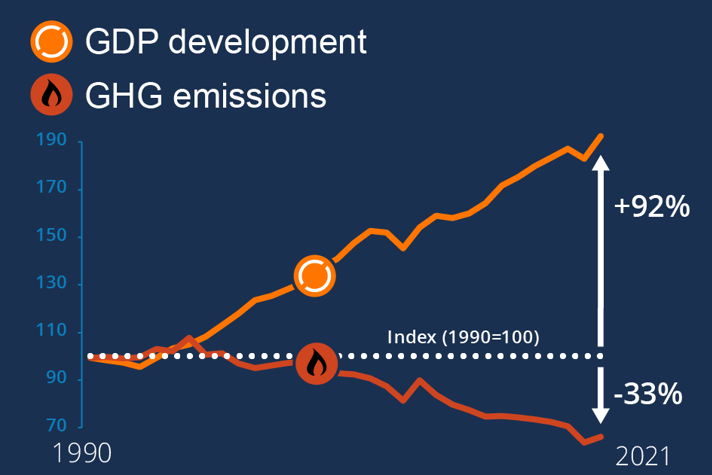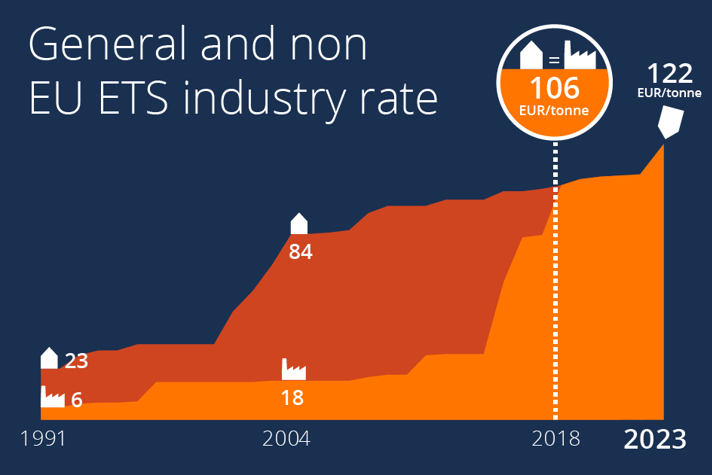Sweden’s carbon tax
Climate change is one of the most pressing challenges facing the international community. A broad range of policy instruments can be used to curb carbon emissions, and economic instruments such as taxes and emissions trading are critical elements of any comprehensive mitigation strategy.

'Polluter pays' principle
Pricing carbon emissions is a way of applying the 'polluter pays' principle, in which the costs of pollution are borne by those who cause it. This ensures that emissions are reduced in the most cost-effective way, while stimulating the development and deployment of new, clean technologies.
Energy sources were first taxed in Sweden in the 1920s. A carbon tax was instituted in 1991, alongside an already existing energy tax, and it remains a cornerstone of Swedish climate policy. Over time, the carbon tax has increased in importance, contributing to a broad range of environmental and climate objectives. For example, the carbon tax provides incentives to reduce energy consumption, improve energy efficiency and increase the use of renewable energy alternatives.
Carbon tax easy to implement
Swedish experience shows that a carbon tax can be easy to implement and administer, at low costs to authorities and operators. This is particularly true if existing revenue collecting systems, such as systems for levying other excise taxes on fuels, are already in place. Another feature of the carbon tax that reduces costs associated with its administration is that tax rates in Swedish tax law are expressed in common trade units (volume or weight).
The carbon tax is levied on all fossil fuels in proportion to their carbon content, as carbon dioxide emissions released in burning any fossil fuel are proportional to the carbon content of the fuel. It is therefore not necessary to measure actual emissions, which greatly simplifies the system. Combustion of sustainable biofuels doesn't result in a net increase of carbon in the atmosphere and hence are not subject to carbon taxation.
Swedish carbon tax rates

The carbon tax was introduced in 1991 at a rate corresponding to SEK 250 (EUR 25) per tonne fossil carbon dioxide emitted, and has gradually been increased to SEK 1 330 (EUR 122) in 2023 (currency conversion based on an exchange rate of SEK 10.87 per EUR). By increasing the tax level gradually and in a stepwise manner, households and businesses have been given time to adapt, which has improved the political feasibility of tax increases. A lower tax rate has historically been applied to industry outside the EU Emissions Trading System (EU ETS), while industry covered by the system is entirely exempt from carbon tax. As of 2018, however, the industry rate outside the EU ETS is the same as the general rate.
Sweden's carbon tax generates considerable revenues for the general budget (there is no 'earmarking' of tax revenues in Sweden). General budget funds may, however, be used for specific purposes linked to the carbon tax, such as addressing undesirable distributional consequences of taxation or financing other climate-related measures.
Articles and reports
- Hammar and Åkerfeldt (2011) CO2 Taxation in Sweden. 20 Years of Experience and Looking Ahead
- Hammar and Åkerfeldt (2015) CO2 Taxation in Sweden. Experiences of the Past and Future Challenges
- Sweden’s Fifth Biennial Report under the UNFCCC
- UN Handbook on Carbon Taxation for Developing Countries (2021). See chapters 6 and 8 in particular for a presentation of the design and administration of the Swedish carbon tax.
Power Point Presentations by officials at the Swedish Ministry of Finance (selection)
- March 2023 – Carbon taxation Sweden – general information
Carbon Taxation in Sweden - November 2017 Addis Ababa, UN Workshop on Practical Issues in Protecting the Tax Base of Developing Countries
Carbon Tax – a Good Idea for Developing Countries - September 2017 Tucson, AZ, USA 18th Global Conference on Environmental Taxation
How to Design a Cost-Effective Carbon Tax on Motor Fuels
Why Carbon Taxation is a Good Idea
Is fuel taxation a source of long-term fiscal revenue?
Statistics
- Current tax rates (Taxes in Europe Database)
- Historical tax rates (Swedish Tax Agency, in Swedish)
- Tax revenues (Swedish Tax Agency, in Swedish)
- Energy use (Swedish Energy Agency)
- Emissions (Swedish Environmental Protection Agency, in Swedish)
Contact persons
Susanne Åkerfeldt
Senior Adviser
Tax and Customs Department
Division for VAT and Excise Duties
Phone: +46 8 405 13 82
Email to Susanne Åkerfeldt
Karl-Anders Stigzelius
Desk Officer
Tax and Customs Department
Division for Tax Policy Analysis
Phone: +46 8 405 30 94
Email to Karl-Anders Stigzelius

 X
X